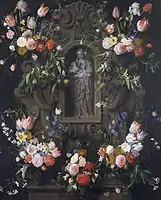Thomas Willeboirts Bosschaert
Thomas Willeboirts Bosschaert (1613 – 23 January 1654) was a Dutch-born Flemish Baroque painter.
Thomas Willeboirts Bosschaert | |
|---|---|
 Thomas Willeboirts Bosschaert self portrait 1637. | |
| Born | Thomas Willeboirts Bosschaert 1613 |
| Died | 23 January 1654 (aged 40–41) |
| Nationality | Belgium |
| Known for | Painting |
| Movement | Baroque |
Biography
Willeboirts Bosschaert was born in Bergen op Zoom, where his Catholic family had moved in the late sixteenth century. He moved to Antwerp in 1628, and entered the studio of Gerard Seghers for eight years. In 1636 or 1637 he became an Antwerp citizen and joined the Guild of St. Luke. He died in Antwerp.
Art
His style was heavily influenced by Anthony van Dyck, both in history and portrait, leading some scholars to suggest that Willeboirts might have studied in that studio.[1] The artist ran his own studio with at least nine known pupils, and collaborated with other artists of the time such as Daniel Seghers, Paul de Vos, Jan Fyt, Jan van den Hoecke, Frans Snyders and Adriaen van Utrecht, as well as with Peter Paul Rubens on the decoration series for Philip IV of Spain's Torre de la Parada (1636–1638). Between 1641 and 1647 he also worked for the Dutch stadtholder Frederik Hendrik of Orange. Hendrik's widow, Amalia von Solms also commissioned a work from Willeboirts for the decorations of the Oranjezaal (Orange Room) in the Huis ten Bosch, a decorative program that included both Dutch and Flemish masters. In 1653, a competition was held in Antwerp between him and Cornelis Schut to create an altarpiece with money that had been allocated for Van Dyck before his death. Schut's painting, The Martyrdom of St. George (Royal Museum of Fine Arts, Antwerp), won.[2]
Willeboirts made the grisaille centerpieces for two of Daniel Seghers garland paintings. For one of these Seghers was awarded with a solid gold maulstick, and Willeboirts was given a hundred guilders.[3]
 Daniel Seghers Garland with Virgin, 1645, paid for with gold maulstick.[4]
Daniel Seghers Garland with Virgin, 1645, paid for with gold maulstick.[4]._Nationalmuseum%252C_Stockholm%252C_Sweden.jpg.webp) Study of a Boy's Head, 1644–1645, by Thomas Willeboirts Bosschaert. Nationalmuseum, Stockholm, Sweden
Study of a Boy's Head, 1644–1645, by Thomas Willeboirts Bosschaert. Nationalmuseum, Stockholm, Sweden
Notes
- Vlieghe, Hans (1994). "Thoughts on Van Dyck's Early Fame and Influence in Flanders". Studies in the History of Art. 46: 210, 214. JSTOR 42622102.
- Baudouin, Frans (1994). "Van Dyck's Last Religious Commission: An Altarpiece for Antwerp Cathedral". Journal of the Warburg and Courtauld Institutes. 57: 187. doi:10.2307/751468. JSTOR 751468.
- Ploeg, Peter van der (1997). Princely patrons: The Collection of Frederick Henry of Orange and Amalia of Solms in the Hague. Hague: Mauritshuis. ISBN 978-9040099878.
- This was the painting Constantijn Huygens referred to in Huygens praise of Seghers's painted flowers (in Latin), IN PRAESTANTISSIMI PICTORIS DAN. SEGHERI ROSAS.
References
- Frans Baudouin, "Van Dyck's Last Religious Commission: An Altarpiece for Antwerp Cathedral," in Journal of the Warburg and Courtauld Institutes, Vol. 57. (1994), pp. 175–190.
- Axel Heinrich, Thomas Willeboirts Bosschaert (1613/14-1654). Ein flämischer Nachfolger Van Dycks. Turnhout: Brepols Publishers, 2003. ISBN 2-503-51143-0
- Rose, Hugh James (1857). "Bosschaert, Thomas Willibord". A New General Biographical Dictionary. 4 BEE–BRA. London: B. Fellowes et al. p. 457.
- Hans Vlieghe. "Thoughts on Van Dyck's Early Fame and Influence in Flanders," in: Van Dyck 350. Studies in the History of Art, Center for Advanced Study in the Visual Arts, vol. 46, edited by Susan J. Barnes and Arthur K. Wheelock Jr., National Gallery of Art, Washington, 1994, pp. 198–220.
| Wikimedia Commons has media related to Thomas Willeboirts Bosschaert. |